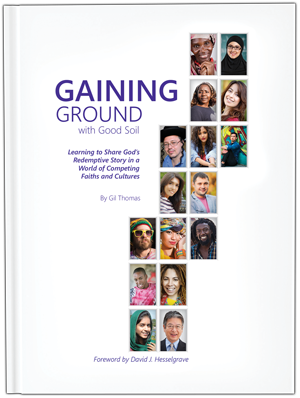Sharing the Gospel Through Your Faith Story, Pt. 1

What is sometimes called “evangelism” or “witnessing” can be as easy and simple as telling your story—the story of what Jesus Christ has done in your life. We call that your personal “faith story.” Here’s how to develop and share your story of faith in a way that your unsaved friends and other acquaintances (even strangers) will enjoy hearing it.
Crafting Your Faith Story
The goal, at this point, is to plan and practice a faith story that you can share in four minutes or less. Brevity is key. Inclusion of gospel content is essential. Organization of the story is important. Here’s a structure that has been proven to work:
The “Before” – Share what your life was like before Jesus changed it.
- Transition into your faith story, as naturally as possible, from where you were in the onion-peeling process of your conversation.
- Share specific symptoms of pre-Christian spiritual needs that led you to realize your need for something that would bring you eternal hope, peace, joy, and so forth.
- Perhaps, share some of your futile human attempts to deal with those symptoms of what we know as “lostness” (without using that term).
The “How” – Share how you came to faith in Jesus Christ, including key gospel truths.
- Share some circumstances that led up to the time when you made your personal faith response to embrace Jesus as your Savior.
- Briefly explain the specific steps you took to make your personal faith response.
- Interweave gospel concepts informally into your story, without sounding like a rote-memorized formula. You may want to take another look at the Chronological Bridge to Life to review the essential content of a gospel presentation.
The “After” – Share the after-effects of your faith response, positive changes in your life.
- Share some of the benefits you have realized from your new life, as a true believer in Jesus Christ.
- Conclude with a statement regarding your confident assurance of eternal life.
Two Faith Story Patterns
The Basic Pattern—Chronological Sequence
The before-how-after organization pattern described above is chronological. It talks about what your life was like before your trusted Jesus, the time surrounding your conversion experience, and then the changes in your life as a result of your conversion.

See and read an example of a Chronological Sequence faith story.
Optional Pattern—Overview and Flashback
This basic (chronological) structure works well for people who are saved in their teen or adult years, especially if they have an interesting “before” story and their “how” experience is helpful in clearly explaining the gospel. But, people who come to true faith in Jesus Christ at a very early age may not have an interesting “before” story and may not remember details of their “how” experience.
If you were saved as a young child, here’s a faith story structure that may work better for you.

Give a brief overview of your life, then flashback to tell your before-how-after stories.
See and read and example of an Overview and Flashback faith story.
Write – Critique – Tweak - Practice – Tweak – Practice – Re-tweak – Polish - Etc. - Use
It takes time and lots of effort to craft a faith story that is coherent, clear, concise, and that contains essential gospel content. The only way to achieve these objectives is to begin by putting your faith story in writing. Then ask multiple people, who understand what you are trying to accomplish, to read it and give you candid helpful feedback. Tweak the story, then practice telling it to a sympathetic listener to get more feedback. Continue this process of critiquing, tweaking, and practicing it until:
- You can tell it from memory in four minutes or less in a way that does not sound memorized and ...
- It embeds the gospel in a meaningful and interesting manner.
Download a form for writing your faith story.
But, how do you know if your faith story will be effective? The next article in this series will include a “tips checklist” for crafting your faith story.
Previous articles in this series:
- Three Greek Verbs Define Good Soil
- Assessing Unbeliever’s Gospel Understanding
- Assessing Gospel Receptivity
- Initial Contact or Relational Evangelism—or Both?
- The Problem of Gospel Static
- One Gospel - Three Worldviews
- Worldview “Noisy” Neighborhoods
- How To Understand Worldviews: I’m an Onion – You’re an Onion
- How To Witness to A Non Believer: 3 Step Guide To Using Verbal & Non Verbal Communication
- Gospel Knowledge Deficiencies
- The Romans Road in “Post-Christian” North America?
- Gospel Tracts in “Post-Christian” North America?
- Evangelism that BEGINS with Jesus – Good or Not So Good?
- Explaining the Gospel – Where Did Jesus Begin?
- Change the Way We Do Evangelism in North America?
- Evangelism – For the Biblically Uninformed
- A Distinctive Evangelistic Bible Study Workbook
- How Many Stories in the Bible?
- Eight Words Summarize the Bible’s BIG Story
- Gotta Pray the Sinner’s Prayer?
- Repent and/or Believe? Two Steps or Two Sides?
- Helping Believers “Hold Fast” to the Gospel

Gaining Ground with Good Soil
An evangelism and discipleship training narrative that is a scaled-down version of the Good Soil E&D seminar in a narrative format. It follows hard-working, dedicated missionaries who are contemplating leaving the field because of a lack of solid fruit. A last-gasp Bible study reveals a theology of evangelism and discipleship that inspires and equips them to continue to pursue their calling. The principles gained from this theology are applicable to anyone wishing to serve God through biblical evangelism and discipleship. Free resources for individual and group study are also available for download. See the "Related Resources" below. 2016 edition. Learn more...



